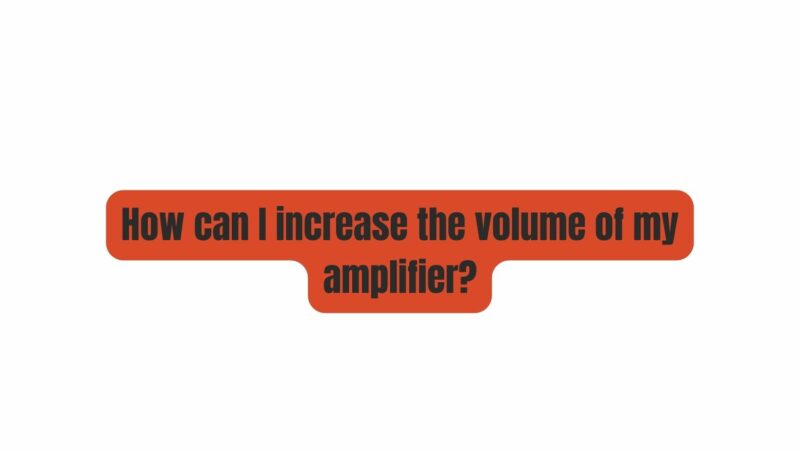The desire for more volume from an amplifier is a common pursuit among musicians, audio professionals, and enthusiasts alike. Whether you’re rocking out on stage, enjoying your favorite tunes at home, or perfecting your recording studio setup, achieving higher volume levels can significantly impact your audio experience. In this article, we will delve into the strategies and considerations for increasing the volume of your amplifier while maintaining sound quality and avoiding potential pitfalls.
1. Power Up Your Amplifier
The most direct way to increase the volume of your amplifier is to ensure that it has sufficient power to meet your needs. Amplifier power is typically measured in watts (W), and a higher wattage amplifier will deliver more volume. Consider upgrading to a more powerful amplifier if your current one is underpowered for your intended application. However, be mindful of matching the amplifier’s power output to the speakers’ handling capacity to prevent damage.
2. Speaker Efficiency and Sensitivity
The efficiency and sensitivity of your speakers play a crucial role in determining how loud your amplifier can go. Speaker sensitivity is typically measured in decibels (dB) and indicates how efficiently a speaker converts electrical power into sound. Higher sensitivity speakers will produce more volume with the same amount of amplifier power. Upgrading to more efficient speakers can be a cost-effective way to increase volume without changing your amplifier.
3. Impedance Matching
Proper impedance matching between your amplifier and speakers is essential for maximizing volume. Check that your amplifier’s output impedance matches the input impedance of your speakers. Mismatched impedance can result in reduced power transfer and lower volume levels. Ensure compatibility or use an impedance-matching device if needed.
4. Use External Power Amplifiers
If you’re looking for a substantial increase in volume, consider adding an external power amplifier to your setup. This allows you to distribute the amplification workload between multiple amplifiers, providing more power and, consequently, more volume. Make sure to configure your setup correctly, and use a crossover if necessary to divide the audio signal between amplifiers and speakers.
5. Amplification Gain Control
Many amplifiers feature a gain control or volume knob that allows you to adjust the amplification level. Increasing the gain will amplify the input signal, resulting in a louder output. However, be cautious not to push the gain too high, as this can lead to distortion and reduced sound quality. Find the right balance between gain and clean amplification.
6. Use a Preamp
Adding a preamplifier (preamp) to your signal chain can provide an additional boost in volume. A preamp amplifies the input signal before it reaches the main amplifier, allowing you to achieve higher volume levels without pushing the main amplifier to its limits. Preamps can also introduce tonal shaping options, enhancing your overall sound.
7. EQ Adjustments
Fine-tuning the equalization (EQ) settings on your amplifier or in your signal chain can impact perceived loudness. Boosting certain frequency ranges, particularly the midrange and upper midrange frequencies, can make the sound appear louder and more present. Experiment with EQ settings to find the optimal balance for your desired volume.
8. External Signal Boosters
For electric guitars and other instruments with passive pickups, external signal boosters or stompboxes can provide an additional volume boost. These devices increase the strength of your instrument’s signal before it reaches the amplifier, allowing you to achieve higher volume levels and more dynamic control.
9. Use a Compressor
A compressor is a dynamic processing device that can help control the peaks and valleys in your audio signal. By reducing the dynamic range, a compressor allows you to increase the overall volume without the risk of clipping or distortion. Use a compressor judiciously to maintain the desired sound quality.
10. Consider Sound Reinforcement
In live performance settings, sound reinforcement equipment such as powered speakers and monitors can extend the reach and volume of your amplifier’s output. These devices are designed for clarity and projection, ensuring that your sound reaches the audience effectively. Integrating sound reinforcement into your setup can be especially beneficial for musicians playing in larger venues.
11. Mastering Proper Gain Staging
Achieving higher volume levels while maintaining sound quality requires proper gain staging. This involves optimizing the input levels at each stage of your signal chain to prevent distortion and noise. Pay close attention to the input and output levels of your equipment, ensuring that signals remain clean as they pass through various components.
Conclusion
Increasing the volume of your amplifier is a goal that can enhance your audio experience, whether you’re performing on stage, enjoying music at home, or refining your recording studio setup. By understanding the principles of power, speaker efficiency, impedance matching, and the use of additional equipment such as preamps and compressors, you can achieve higher volume levels while preserving sound quality and avoiding distortion. Experimentation and careful adjustment of settings are key to finding the perfect balance for your specific needs and preferences. With the right approach, you can unlock the full potential of your amplifier and enjoy a louder, more impactful audio experience.


